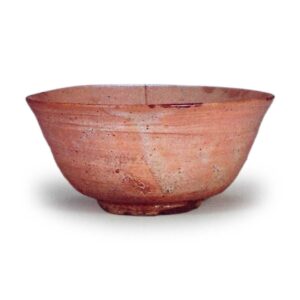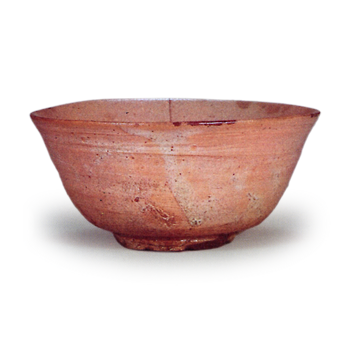
Great masterpieces. Korean tea bowl, fishmonger’s honka. In the possession of Sen no Rikyu. To-to is a slang word for fish, and totoya means fishmonger. Also written as “totonoya. In “Suikyoroku,” it is written, “There is a pottery called Toto-ya, which was kept in a fishmonger’s store at one time, but Rikyu found it and kept it as a treasured possession. In other words, this type of tea bowl came to be called “totoya” after Rikyu found this tea bowl lying on the shelf of a fishmonger’s shop. However, there is another theory. In the “Chawan Meri-sho” (Tea Bowl Book), it is written, “In Sakai, a merchant called Totoya has a tea bowl called Totoya, which was brought by a Sakai merchant who entered Tang Dynasty China. There are various theories, such as, “Totoya was loaded on a ship that arrived at the port of Sennan in the direction of Toonya Whatsitashi, which must have given it that name. This tea bowl is thinly made, the edge of the mouth is warped, and there are fine streaks like brush strokes in the outer wheel with a stepped pattern. The rim is thin, partly glazed and partly showing rat-colored clay, and the center of the bottom is slightly elevated and the area around it is concave. The bottom is slightly elevated in the center and concave around the bottom. There are six areas where the clay is chipped off along the bottom rim, and the area around the base is glazed on half the surface and shows clay on the other half. There are also some areas where the white glaze has been dripped diagonally from the mouth rim on top of the overall light red color, and there are also areas where the glaze is scattered unevenly like clouds to form a landscape, and there are two vertical gutters reaching from the mouth rim to the hem, several small repairs on the interior mouth rim, and a small soaking pattern, and the prospective mirror drop is extremely large. There are also some small spots of soaking. There is a shallow wheel-thrown pattern all over the surface of the prospect, and the center is concave, forming a tomoe shape, and there is also a white glaze over the prospect. Among the Uoya teacups, this kind of workmanship and glazed taste is almost unparalleled. It is no coincidence that they have been highly prized among adults since ancient times. At first, Rikyu found this tea bowl in a fishmonger’s shop in Sakai and kept it as a treasured possession, but later gave it to Furuta Oribe.
Oribe sold it before he served in the Joseon Dynasty, but Kobori Enshu purchased it and gave it to Enshu. It is said that Oribe sent the bag to Muneho on the eve of the fall of Osaka Castle. It has been in the Kobori family for a long time, and is said to have been used by Ming Rikyu and Rikyu Maru, the jar with a Rikyu crane on the top.
In 1904 (Meiji 37), it entered the Fujita Heitaro family in Osaka. Currently in the Fujita Museum collection. (Ko-Meibutsu-ki, Gan-kan Meibutsu-ki, Meibutsu-ki, Kokin Meibutsu Ruiju, Sakurazan Ippu-ki, Suiko-ki, Soyu-ki, Kankai Gyotsu, Yukimaso, Teabowl Meiri-sho, Kanso Zoki, Tea Ware Handbook, Meibutsu Chawan-shu, Taisho Meiki-kan,)



